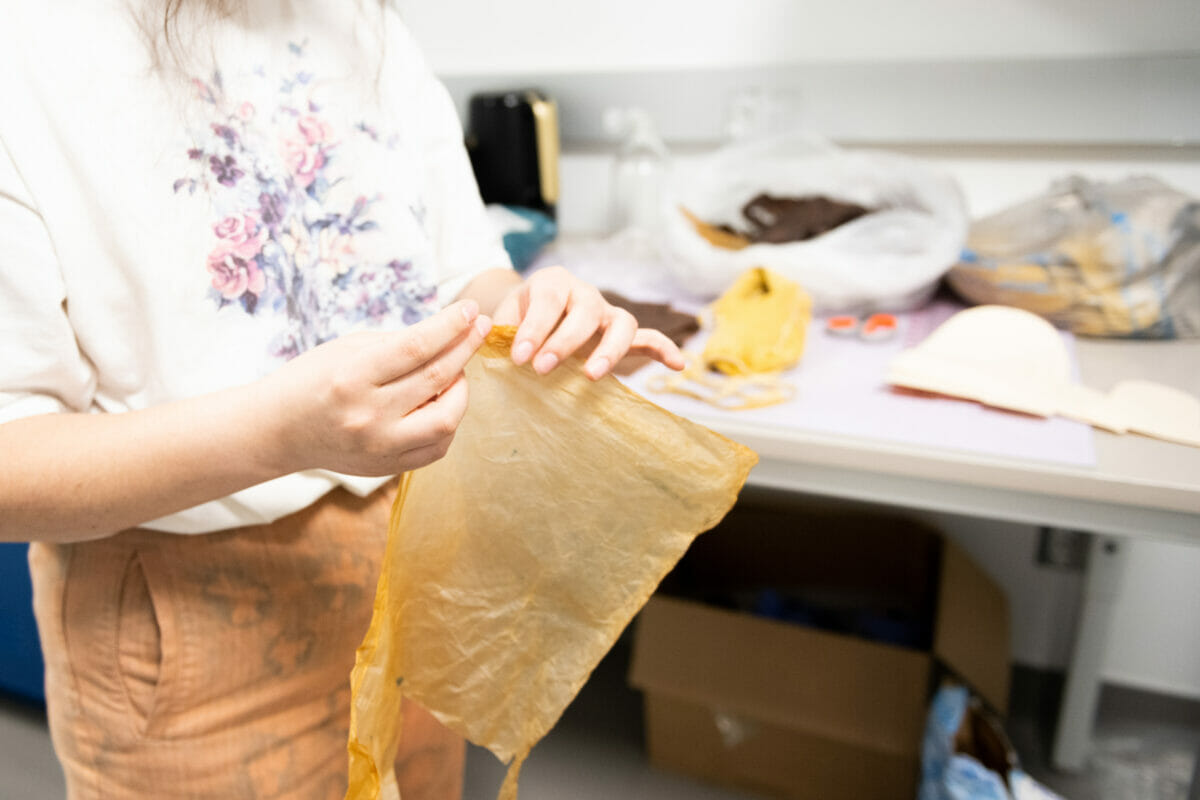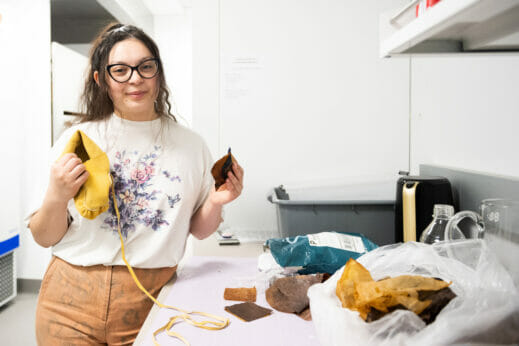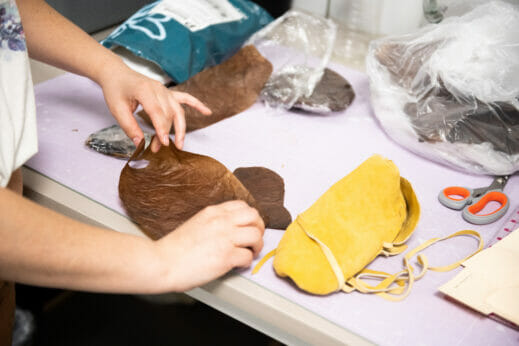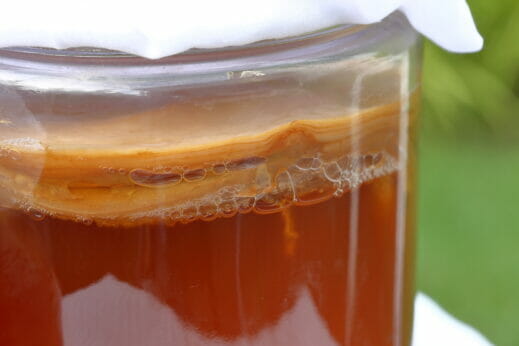Researchers and entrepreneurs consider kombucha and fermented biopolymers as a sustainable source material for clothing, car interiors and more.

Kombucha is widely consumed as a fermented, effervescent tea. But some people in the world of textiles look at kombucha and see something else. Asiah Brazil-Geyshick, an Ojibwe student studying apparel, textiles and design at the University of Idaho, saw a pair of moccasins, a medicine bag and a wallet, all of which she hand-stitched from dried kombucha SCOBY, a symbiotic culture of bacteria and yeast.
Alternative textiles aren’t new, but the use of sustainable materials in the industry, while still a small percentage overall, is growing. In an attempt to combat the unsustainable consumption of clothing and other materials made from synthetic fibers, scientists and entrepreneurs have considered other more environmentally friendly alternatives, such as algae and mycelium.
Kombucha tea is made from tea, sugar and a SCOBY. The SCOBY takes the shape of a gelatinous mat, and when it’s dried out and shaped, it can resemble leather or fabric.
SCOBY has its advantages as a material since it’s environmentally sustainable to produce and also biodegradable at the end of its life. But it also has drawbacks. For example, it sponges up water in a way you don’t want clothing to do. Still, with a little bit of experimentation, Brazil-Geyshick made several items out of this material. In the future of sustainable textiles, can kombucha become a prominent player?

Asiah Brazil-Geyshick holds leather in her right hand and kombucha leather she made in her left hand. (Photography courtesy of University of Idaho)
Homegrown
Chelsey Byrd Lewallen teaches an introduction to textiles class at the University of Idaho. In the class, she covers non-traditional textiles, such as coconut, orange peel and more.
Byrd Lewallen brought up the prospect of kombucha leather in her class, along with the idea of partnering with a local company, Love’s Kombucha, to try and make a usable leather alternative out of SCOBY. Her student, Brazil-Geyshick, was inspired and volunteered to take on the project.
“I got excited because I’m Native American, and we use a lot of leather,” says Brazil-Geyshick.
Byrd Lewallen and Brazil-Geyshick began doing research, gathering materials and learning from others who had experimented with this material.
After mixing the materials and growing the SCOBY, Brazil-Geyshick took the thick and rubbery mats—“It feels like raw chicken,” she says—and washed them in soapy water. This removed the fermentation smell and some of the stickiness. After washing, she dried and rubbed them with glycerin.

Asiah Brazil-Geyshick shapes fabric made out of SCOBY. (Photography courtesy of University of Idaho)
It was a lot of trial and error—some things worked really well, such as rubbing glycerin into the SCOBY to prevent it from becoming too brittle, a tip they picked up from Armine Ghalachyan at Washington State University, who is well versed in working with kombucha. Other things were less successful, like when they had the wrong proportion of sugar in their recipe, causing the material to fall apart.
Once the material was made, dyed, dried and ready to work with, Brazil-Geyshick began creating.
“It’s really fun to do your own natural stuff,” says Brazil-Geyshick.
The material is not waterproof, Byrd Lewallen and Brazil-Geyshick say, but they’re still optimistic that it can be useful with additional experimentation and that it can be part of a wave of sustainable materials that will help shift the needle away from fast fashion and its hefty environmental impact.
“I think we [as a society] can do better,” says Byrd Lewallen. “I know we can do better.”
Beyond the SCOBY
Byrd Lewallen and Brazil-Geyshick are far from the only ones experimenting with kombucha as a textile. Fashion designer Suzanne Lee, who founded Biocouture and Biofabricate, brought the potential for kombucha textiles into the public eye. Scientist Theanne Schiros partnered with the brand Public School to style a fashionable sneaker using SCOBY. Today, there is a handful of companies and researchers experimenting with the raw material or specific elements derived from or inspired by it and creating usable textiles.

Kombucha SCOBY in a jar. (Photography: Shutterstock)
Zimri T. Hinshaw, founder and CEO of Bucha Bio, began growing kombucha under his roommate’s bed for use in textile development. But, over time, he realized that, for his purposes, he didn’t actually want the SCOBY itself but a byproduct of fermentation called bacterial nanocellulose.
“It imbues things with immense tensile strength,” says Hinshaw. So, now, Bucha Bio uses bacterial nanocellulose as a raw ingredient to make its composite products stronger. The company no longer brews kombucha, but it sources the bacterial nanocellulose from a larger producer of fermented products.
SCOBY as a textile can be brittle to work with and vulnerable to water, which is why Hinshaw chose to change paths and instead use an isolated element that would give his products—usable in everything from car interiors to clothes—strength without the SCOBY-associated drawbacks.
“If it reabsorbs water in, say, a rainstorm … on your skin, that’s gonna feel pretty gross,” says Hinshaw.
Bucha Bio’s composite materials are also made from bio-based resins and additives, as well as pigments from fruit and algae. The strength added by the bacterial nanocellulose is a significant boon for functionality.
According to Hinshaw, the interest in sustainable materials in the textile industry is tangible, but the path is not yet paved.
“In terms of the startups, there’s not been one clear winner,” says Hinshaw. “We haven’t had our Impossible Foods or our Beyond Meat yet. So, the potential is any one of these number of startups could be that.”
Hinshaw’s advice for consumers is to consider their buying power and do research to find materials that are holistically sustainable.
“Try to buy something made out of next-gen materials, rather than another recycled PET [polyethylene terephthalate] material like another recycled shoe,” says Hinshaw. “That’s great, but it’s not the future.”